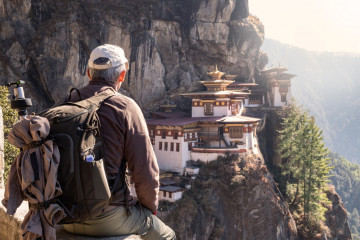In Bike & Hike tours, some sections are covered by mountain bike, while others are climbed on foot. In this way, you can get even more from your mountain adventure. Several miles of forest roads with a moderate gradient? Clearly too boring to walk! But on your bike, you can get there fast and finish the trail in record time. Steep and rough trails, however, should preferably be conquered on foot. To ensure that your combination of mountain biking and mountaineering is a complete success, just do three checks in advance:
1. Technology check: safety first!
On Bike & Hike tours, you need to be able to rely on your bike. That’s why it’s important to give it the attention it deserves. So take your time before hitting the road to check its technical functionality.
• Brakes: Check the braking power of your bike. Just glancing at the pads can give you a first impression of the general condition.
• Gears: Check the settings of your gears. A damaged rear dérailleur significantly affects your comfort and safety while riding.
• Tyre pressure: Adjust the pressure according to the load on the tyres. The permissible pressure range of your tyres is marked on the outer side.
• Tread depth: Prevent slips and falls by having sufficient tread depth on your tyres. Therefore: If the lugs in the middle are visibly worn off, a new tyre should be used.
• Lights: Especially with rechargeable or regular battery-powered lights, you should think about replacing them or having a charging option.
2. Outfit check: Dressing well has to be learnt
The date is set for your Bike & Hike tour, and you check the weather forecast daily. One thing’s for sure: One or two showers are coming. And then there’s the combination of mountain biking and mountaineering. The right clothingis essential here. The multilayer principle has proven itself:
• BASE LAYER: This lies directly against the skin and transports sweat towards the outside. Suitable underwear is the starting point for permanent comfort. With their removable gel pad, these breathable boxers are ideal both for descents by bike and trails on foot.
• MIDLAYER: This serves as a warming insulating layer. Light, elastic and highly functional materials are used.
• SHELL LAYER: This is adapted depending on the place and type of use. It insulates, protects against sun, water and wind and must be extremely hard-wearing. The JACPACK BAG, which transforms into a protective rain jacket in seconds, is the ideal shell layer: Storage space meets rain protection.
Hiking boots on your feet are equivalent to the tread on your tyres. Sturdy footwear ensures your safe footing over rough terrain.
3. All-round check: Equipped for every eventuality
Whether you’re in the Dolomites, the Ötztal Alps or the Großglockner, the following items should be on your packing list:
• Bike lock: While you’re ascending to the summit on foot, you shouldn’t need to worry about your bike. Safely locked at the hut, it waits for your return.
• Helmet: Opt for a space-saving helmet model. The climbing helmet also protects your head while cycling, making it suitable for biking and hiking alike.
• Spare parts: A flat tyre on the road should not mean the end of your tour! Pack an extra tube or repair kit and the right tools.
• Food supplies: Even though the next hut isn’t usually too far away, you should always have enough water and a small snack with you.
Adapted to your personal level of performance, you can now relax while enjoying your Bike & Hike adventure.


